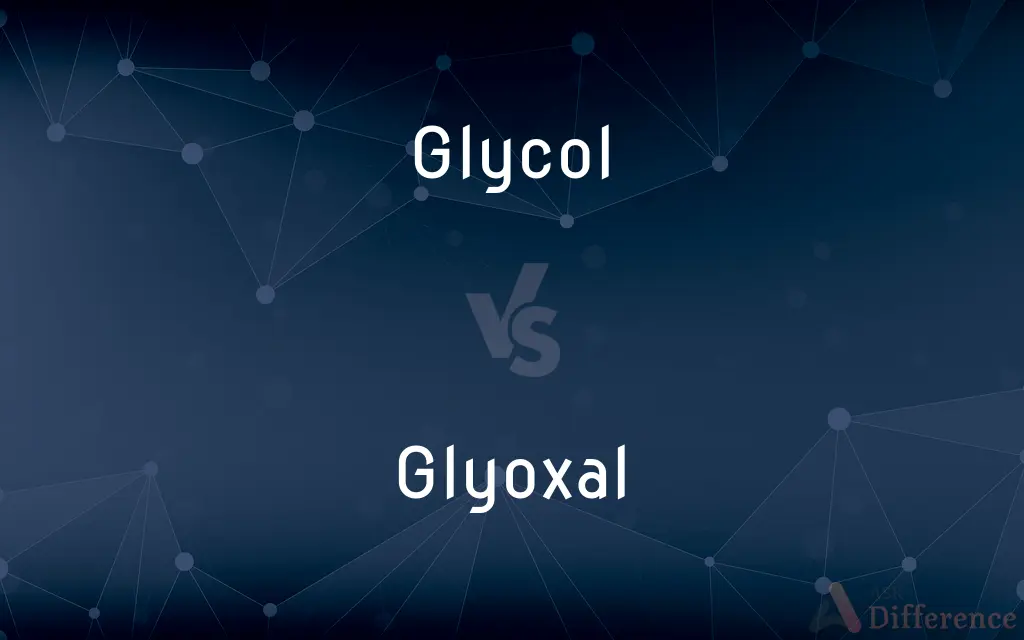Glycol vs. Glyoxal — What's the Difference?
By Tayyaba Rehman & Maham Liaqat — Published on March 4, 2024
Glycol, a simple diol compound, is commonly used as an antifreeze; glyoxal, a dialdehyde, serves in crosslinking polymers and textiles. Both play crucial roles in chemical and industrial applications but differ in their functional groups and uses.

Difference Between Glycol and Glyoxal
Table of Contents
ADVERTISEMENT
Key Differences
Glycol, specifically ethylene glycol, is primarily recognized for its application in antifreeze formulations due to its ability to lower the freezing point of water. Glyoxal, on the other hand, is valued for its ability to crosslink polymers, improving the durability and strength of various materials, including textiles and paper.
Glycols are characterized by their two hydroxyl (-OH) groups attached to different carbon atoms, contributing to their solubility in water and alcohol. Glyoxal possesses two aldehyde (-CHO) groups, making it highly reactive with nucleophiles, a property utilized in producing resins and plastics.
In terms of toxicity, glycols, while toxic when ingested in significant amounts, are generally less hazardous compared to glyoxal, which is more reactive and potentially more harmful due to its aldehyde groups.
Environmental impact varies between the two; glycols are biodegradable under aerobic conditions, whereas glyoxal, due to its reactive nature, may participate in complex chemical reactions in the environment, affecting its biodegradability.
Their applications in industry diverge significantly: glycols are used in coolant and antifreeze solutions, whereas glyoxal's crosslinking properties find use in the textile industry, paper production, and in manufacturing water-soluble resins.
ADVERTISEMENT
Comparison Chart
Chemical Structure
Diol (two -OH groups)
Dialdehyde (two -CHO groups)
Primary Use
Antifreeze, solvent
Crosslinking agent in polymers
Solubility
Soluble in water and alcohol
Reacts with water, less soluble
Toxicity
Moderately toxic if ingested
Potentially more toxic due to reactivity
Environmental Impact
Biodegradable under aerobic conditions
Participates in complex reactions, affecting biodegradability
Compare with Definitions
Glycol
A compound with two hydroxyl groups.
Ethylene glycol is used as an antifreeze in radiators.
Glyoxal
Ingredient in resin formulation.
Glyoxal is a component in some adhesive resins.
Glycol
Humectant in cosmetics.
Butylene glycol helps to retain moisture in skin care products.
Glyoxal
Stabilizer in polymer solutions.
Glyoxal prevents gel formation in polymer emulsions.
Glycol
De-icing agent.
Ethylene glycol is sprayed on aircraft wings to prevent ice formation.
Glyoxal
A dialdehyde compound.
Glyoxal is used for crosslinking in textile finishing.
Glycol
Intermediate in chemical synthesis.
Glycol is used in the production of polyester fibers.
Glyoxal
Chemical intermediate.
Glyoxal serves as a building block in organic synthesis.
Glycol
Solvent for inks and paints.
Propylene glycol is a common solvent in pharmaceuticals.
Glyoxal
Preservative in cosmetics.
Glyoxal acts as a preservative in some cosmetic products.
Glycol
Any of various diols, usually containing vicinal hydroxyl groups.
Glyoxal
(organic compound) The dialdehyde ethanedial derived from ethylene glycol; it is used in the preparation of modified starch for the paper industry.
Glycol
Ethylene glycol.
Glyoxal
A white, amorphous, deliquescent powder, (CO.H)2, obtained by the partial oxidation of glycol. It is a double aldehyde, between glycol and oxalic acid.
Glycol
(organic chemistry) Any aliphatic diol.
Glycol
(organic compound) A thick, colourless liquid, C2H4(OH)2, of a sweetish taste, produced artificially from certain ethylene compounds and used as an antifreeze; ethylene glycol.
Glycol
A thick, colorless liquid, C2H4(OH)2, of a sweetish taste, produced artificially from certain ethylene compounds. It is a diacid alcohol, intermediate between ordinary ethyl alcohol and glycerin.
Glycol
A sweet but poisonous syrupy liquid used as an antifreeze and solvent
Glycol
Any of a class of alcohols having 2 hydroxyl groups in each molecule
Common Curiosities
Can glycol and glyoxal be used interchangeably?
No, their different functional groups mean they serve distinct purposes in industrial applications.
Is glycol toxic?
Glycol can be toxic if ingested in large quantities, but it is generally less hazardous than glyoxal.
What makes glyoxal unique in industrial applications?
Its ability to crosslink polymers and textiles, enhancing material strength and durability.
What is glycol used for?
Glycol is primarily used as an antifreeze, solvent, and humectant.
How does glyoxal contribute to the textile industry?
It is used for crosslinking, improving the durability and strength of fabrics.
Are both glycol and glyoxal water-soluble?
Glycol is soluble in water and alcohol, whereas glyoxal reacts with water and is less soluble.
How do glycol and glyoxal differ in toxicity?
Glycol is moderately toxic, while glyoxal's reactivity makes it potentially more harmful.
What role does glycol play in de-icing?
It is used as a de-icing agent for aircraft and other surfaces to prevent ice formation.
How are glycol and glyoxal different in terms of chemical structure?
Glycol contains two hydroxyl groups, while glyoxal has two aldehyde groups.
What is the environmental impact of glyoxal?
Glyoxal can participate in complex chemical reactions in the environment, affecting its biodegradability.
What are the primary industrial uses of glycol?
Used in coolant and antifreeze solutions, and as a solvent and humectant in various products.
Can glycol be used in cosmetics?
Yes, it serves as a humectant and solvent in various cosmetic products.
How are glycol and glyoxal produced?
They are synthesized through different chemical processes, tailored to their unique structures and uses.
Is glyoxal biodegradable?
Its reactivity can affect its biodegradability, making it potentially less eco-friendly.
Can glyoxal be used as a preservative?
Yes, in some cosmetic products, glyoxal functions as a preservative.
Share Your Discovery

Previous Comparison
Indoor Basketball vs. Outdoor Basketball
Next Comparison
Nano SIM vs. Micro SIMAuthor Spotlight
Written by
Tayyaba RehmanTayyaba Rehman is a distinguished writer, currently serving as a primary contributor to askdifference.com. As a researcher in semantics and etymology, Tayyaba's passion for the complexity of languages and their distinctions has found a perfect home on the platform. Tayyaba delves into the intricacies of language, distinguishing between commonly confused words and phrases, thereby providing clarity for readers worldwide.
Co-written by
Maham Liaqat















































